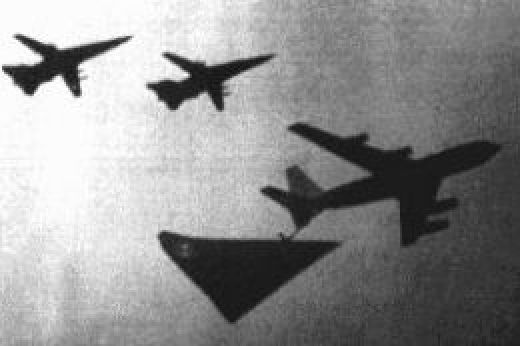Text
I'm not a fan of China and its military.
But this artwork for a Chinese military magazine shows that they are really going to get head on with the United States using cloned, copied or stolen technology.
While the world already knew that the term "Made in China" is the same as inferior in quality, however, quantity has a quality of its own as the Chinese can produce shit at faster rate than its adversaries, such as the United States.
Also, while stealing technology is frowned upon, it has its own advantage that puts the Chinese military's development and production ahead than the other leading superpowers. Stealing or copying technology will save the Chinese engineers time and money in the research & development, as well as spare them from the faults and malfunctions that developing and testing new technologies will produce.
Here I can see Chinese copies of the Boeing C-17 Globemaster (Xi'an Y-20), Lockheed Martin F-22 Raptor / F-35 Lightning (Shenyang FC-31), and the Northrop Grumman B-2 Spirit / B-21 Raider stealth bomber (Xi'an H-20). The aircraft carrier also has similarities to the US Navy's Nimitz and Ford-class of nuclear-powered supercarriers.

#military#chinese military#people’s liberation army navy#aircraft carrier#copied technology#stolen technology#us navy#us military#stealth fighter#stealth bomber#chinese aircraft carrier#chinese stealth fighter#aviation#navy#aircraft#warship
9 notes
·
View notes
Text
but who cares? it's just us



please please PLEASE reblog this if you care
36K notes
·
View notes
Text

A computer-generated image of the formation Chris Gibson witnessed in 1989, showing two F-111s flying behind a KC-135 tanker refuelling the alleged "Aurora type" aircraft in the center.
#aviation history#avgeek#aerospace#aircraft#us air force#hypersonic#lockheed martin#skunkworks#northrop grumman#secret project#classified#advanced technology#airplane#military jet#military#air force
23 notes
·
View notes
Text

Lockheed Martin’s ASTRA
Advanced Stealth Technology Reconnaissance Aircraft (ASTRA), Air Vehicle Six (AV-6) 90-2414, Aeroplane and Armament Experimental Establishment, Boscombe Down, Wiltshire, 1994.
Although there's never been any official confirmation as to the existence of ASTRA, there’ve been numerous eyewitness accounts, strange sonic booms heard over Europe and grainy images of aircraft similar in shape and design posted on the internet. The aircraft is able to fly at ultra-high speeds, Mach 5 and beyond, and operated from undisclosed sites in the US, and occasionally overseas, during late 1980s and throughout the 1990s.
The most significant sighting of AV-6 occurred on the night of September 26, 1994. Taking off from Runway 23 at the Wiltshire test establishment, a malfunction of one of the engines following the application of military power caused the American crew to abort. Eyewitnesses say the aircraft’s nose-wheel collapsed as a result of the excessive braking, leaving AV-6 stranded on the runway.
What followed was one of the largest security operations in the UK, with areas inside and just outside Boscombe Down sealed off by members of the Special Air Service. Within hours unmarked US Government-operated Gulfstream jets began arriving at airports within the local area, after which their passengers were driven straight to Boscombe Down.
The aircraft was quickly removed from the runway and stored in a hangar until a USAF C-5C Galaxy, diverted from Ramstein AB, Germany, arrived to take it back to the US. The Galaxy departed Boscombe Down on the evening of September 28, using the non-standard callsign ‘Lance 18’ for KPMD, the International Civil Aviation Organisation (ICAO) airfield designator for Palmdale, California – better known as Air Force Plant 42 and home to the classified assembly lines of both Lockheed Martin and the then Northrop Advanced Development companies.
LOCKHEED MARTIN'S ASTRA, AV-6
Cockpit: The tandem cockpit arrangement seats a Reconnaissance Systems Operator beneath an SR-71 style rear canopy, with very little forward vision. The pilot has a more conventional fighter-like canopy, although unusually it hinges forward to allow access. Eyewitness reports from Boscombe Down said that when the aircraft was in the hangar following the crash, the middle section was covered with a tarpaulin, leaving the tail and nose areas exposed. It’s presumed that the crew members wore David Clark full pressure suits similar to those worn by personnel in the SR-71 and U-2, as the ASTRA flies at even higher altitudes and speeds.
Tail Section: The outward canted tailfins were new to aircraft designers in the late 1980s and early 1990s, but improvements in military flight control systems (FCS) enabled the outward canted twin tail arrangement to become fitted as standard on the Lockheed Martin YF-22 Lighting II and Northrop/McDonnel Douglas YF-23 Black Widow a few years later.
Nose Area: ASTRA has chines extending from the forward nose section similar to those on the SR-71 Blackbird, it is presumed that the stealthy leading edges of these sections contain passive intelligence or EW gathering systems.
Size: The size of the charcoal-coloured AV-6 is open to debate, but it is believed the aircraft fits into a USAF C-5 Galaxy with some small-scale disassembly. The Boscombe Down example was transported back to Air Force Plant 42 in a C-5 in just one flight.
Source:
#us military#us air force#hypersonic#secret project#aurora#military#technology#airplane#military jet#true events#real story#aircraft#classified#advanced technology#aviation history#avgeek#aerospace#lockheed#lockheed martin#northrop grumman#skunkworks#air crash#airplane crash#hypersonic aircraft#jet#military aviation
32 notes
·
View notes